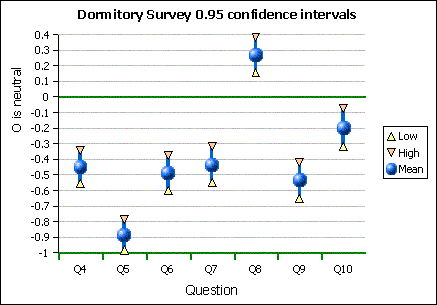
The dormitory survey was conducted in mid-September, 2003. There were seven core questions followed by space for comments. The seven core questions were numbered four to ten (the first three questions were demographic: name, gender, and class).
The mean response for each question was in the negative - for six of the seven questions dormitory students, on average, responded in disagreement with the statement. The only question that yielded agreement on average was question eight on the effectiveness of students as residence hall assistants.
The following chart depicts the mean for each question and the boundaries of the 95% confidence interval for that question.

Dormitory students most strongly disagreed with question five. Question five stated that the dormitory is well maintained, painted, cleaned, repaired, and has adequate facilities. Comments written by the students echoed this concern, with a focus on the condition of the bathrooms.
After question five, questions six, seven and nine had the highest frequency of strong disagreement. The dormitory students have strong concerns about maintenance of the dormitories, provision of adequate living space, supervision by staff, and sufficiency of social activities.
The focused self study in 2000 noted that residence hall maintenance was evaluated negatively by 63.5% of the students surveyed. This negative rating has increased to 78% of the students surveyed. Sixty percent of students thought that there were not enough good social activities happening in the residence halls, this has climbed to 63%. Fifty-five percent of the students indicated that residence hall supervision was not good, this has risen to a 59% negative rating. On key metrics the college is doing worse than three years ago.
The student comments could be categorized by a limited number of themes, with the need to repair and maintain the bathrooms leading the list.
| Category | Frequncy |
|---|---|
| Bathroom: clean, repair, fix faucets, etc. | 20 |
| TV VCR movies: Buy new VCR, allow TV every night. | 19 |
| More bus trips especially to the river, weekend overnights. | 11 |
| General ongoing clean up. | 9 |
| Control noise, enforce quiet hours, keep halls quiet. | 8 |
| Bring in new management, change dormitory supervision. | 7 |
| Repaint facilities. | 5 |
| Fix and improve the laundromat, make the machines free. | 5 |
| Prevent drunk students and outsiders from coming in dormitories. | 4 |
| Install air conditioning. | 3 |
| Provide a store in the dormitory. | 2 |
| Abolish quiet hours. | 2 |
The frequency refers to the number of times the item was mentioned by different students. Statistically indistinguishable from the concern over the state of repair of the bathrooms was the desire for a new VCR and television along with extended viewing hours. The third most frequent comment category focused on increasing the number of bus trips, both to town in the evenings and to rivers on the island. This category also included comments favoring more overnight trips to lagoon islands.
Of concern, but on a lower tier than the earlier items, is the need for general clean up, repainting, noise control, and a change in the supervision of the dormitories. Among these comments three specifically critiqued management of the women's dormitory.
While the survey queried security in the residence hall, the survey did not also query perception of safety on campus nor security on campus. The survey also did not seek to gather information on health related problems the students might have had, whether these were resolved, and by who the problem was resolved. The survey also did not specifically seek information that might reveal unreported incidents of violence against women and men.
The survey also did not seek to determine what recreational and social activities the students would like to see implemented. No questions sought to determine the order in which the college might pursue construction of further sports recreational facilities. Informal, unpublished surveys have suggested that the students would prefer a track and ball field be pursued next by the college. Improving the equipment in the weight room was also mentioned by some students.
In this day and age understanding the sexual habits of young people is critical to predicting the potential impact of HIV/AIDS. Other indicators including rates of gonorhea and pregnancy suggest that the student population remains at risk from HIV/AIDS. Any such study should be carefully designed in consultation with external experts from other parts of the Pacific which are experiencing the AIDS crisis and who have experience in constructing survey questions targeting Pacific Island youth. Due to the unique relationship of the college to the dormitory students, the dormitory students should be a first priority in any such survey. Anecdotal evidence suggests that multiple-partnering, serial monogamy with multiple partners over time, and unsafe sex are not uncommon in the dormitory. Understanding the actual rates will be critical to developing educational and intervention programs.